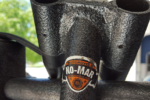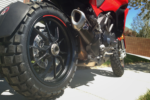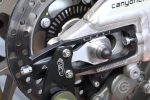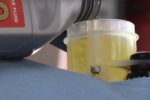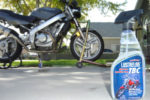For years we’ve been saying the same thing; we’ve said it so many times now that it’s starting to sound repetitive, but it’s simply, totally and unequivocally true. Tires just keep getting so much better and better, so much so, that it’s rare for us to be unimpressed with a tire’s performance. Almost every tire we try these days is just incredible, particularly when compared to tires from just a few years ago. But every once in a while, one tire tends to jump ahead in terms of grip, handling and wear.
The first version of the Angel GT was called the Angel/Demon ST. It was a good tire, it didn’t do anything wrong. The Demon pattern in the tread that wore down from a demon and then became an angel after the first few miles was silly enough that we took the tire less seriously. But, we had a positive experience then moved on to the next tire. But then Pirelli announced a change, calling the tire the GT and dropping the silly Angel/Demon gimmick. So as it was, when the Multistrada 1200 was due for new tires, we threw on a set and honestly have not looked back, and we’ve had a hard time installing anything else ever since.
The Brochure
Pirelli says the tire stretches the concept of Sport Touring (ST) into Gran Tourismo (GT) bringing the sporty attitude to a wider range of conditions for longer distances with consistent performance until the end of the tires life. Sounds a bit like marketing hype; but the GT does use a zero-degree belt that enhances carcass strength and makes for a very consistent profile shape – the belts run at zero-degrees difference from the sidewall. They also claim they are using what they’ve learned from World SuperBike Racing to create a carcass that, no matter the lean angle, the tire will provide the largest contact patch possible.
The new GT is a dual compound mileage tire, using a brand new Pirelli invented compound combination with lots of silica to help the tire warm up quicker and last longer, resulting in a tire designed specifically for those of us who pack in enough miles to necessitate an oil change in a single week of riding. You know, riders like us.
Pirelli says they put a lot of thought into how this tire would behave in the wet. As is common on many designs these days, the front tire pushes water away from the rear, so the rear has no sipes or cuts down the center of the tire. This helps the tire last longer but also allows the rear sipes to only have to deal with water while leaned over. You’ll notice on the GT that the sipes start out narrow, get wider then taper off before the edge of the tire. This allows the tire to move water away in wet conditions as well as for more rubber to be in contact with the asphalt in dry conditions at maximum lean.
Typically GT means the tire was designed for heavier bikes, but with the Pirelli the GT is the “base” model. It also comes in an A-Spec for heavier bikes like FJRs and ST’s or riders who ride with a passenger most of the time. There is also a D-spec designed specifically for the Ducati Multistrada GT, although nobody seems to be able to tell us exactly what is different between a traditional GT and D-spec.
Handling
The first thing we noticed when running the Angel GT is that this is a much stiffer carcass that your traditional Pirelli, so you get a lot more communication and consistent feedback from the tires without compromising too much comfort or compliance.
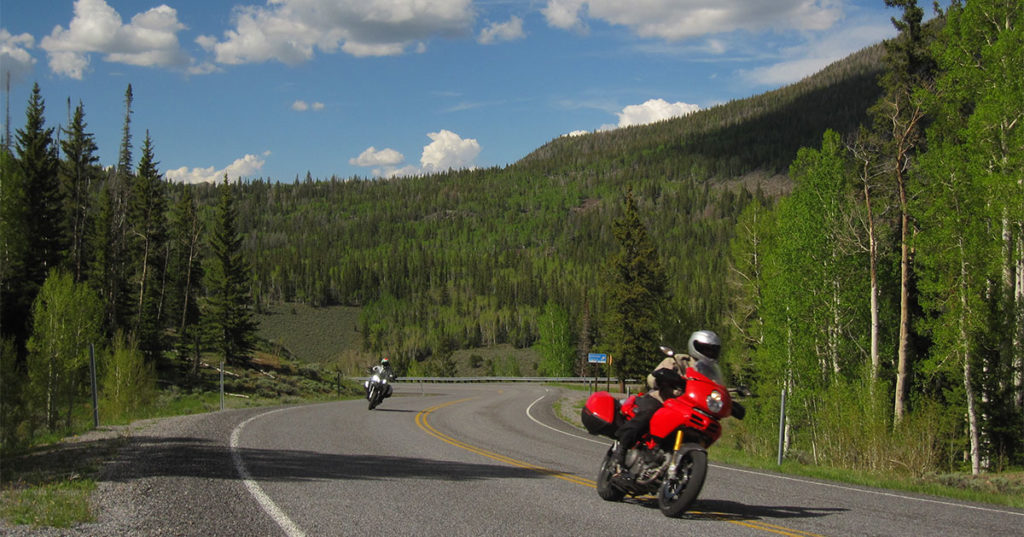
The profile for the front tire is pretty sporty by most mileage-tire standards, and even a bit pointy compared to many former Pirelli sport tires, but just like with carcass flex, Pirelli managed to strike a nice balance, creating a turn-in profile that is light and quick without being skittish or flighty. From gentle bends to fully heeled over, the tire profile works great regardless of lean angle.
What you end up with is a tire that is virtually transparent without the “ignorance is bliss” sensation. You know exactly what the tire is doing without it ever being distracting or unnerving. At the same time the tire seems happy to do whatever you ask of it without any fuss. Even quick transitions into tight, hair-pin bends, you can feel the carcass flex as it should, but not so much that it feels like the tire is going to come out from underneath you. Even under hard trail-braking, the tire performs consistently and precisely.
In the real world of riding, that means you can dedicate more of your attention to the road, finding your apexes, driving to your exits, without having to worry if the tire is up to the task.
Grip
It’s almost hard to believe that this tire is a high-mileage, Gran Tourismo, touring tire. The grip is hard to discern from Hypersport track-day tires in almost every condition, save super-hot temperatures, which is the cost of having lots of silica. Silica helps a tire warm up, shed water and last a good, long time, but doesn’t deal with super-hot temperatures as well. But for most of us, the quick warm-ups are fantastic particularly on those early morning starts from high-elevation. The tire warms up quickly enough that you’ll find yourself twisting your bike into the bends in short order, and even if the rain starts to fall the tire seems unfettered.
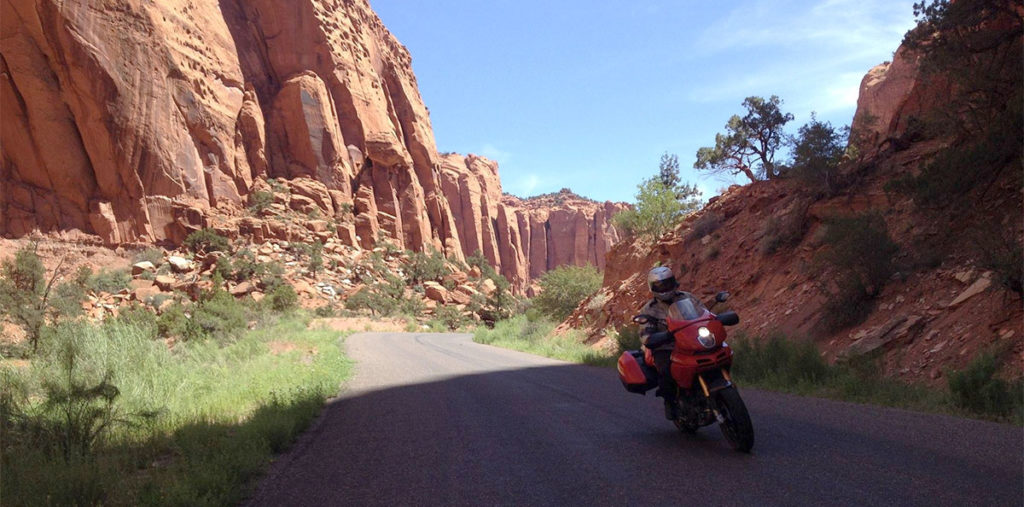
Dropping out of Crater Lake we were caught in the worst rain-storm we’d ever seen. Water so deep on the roads that we were pushing a wake as we tried to make our way back down the mountain. Not once did the Angel GT bat an eye or even so much as threaten a slip. In fact, the only real slide I had with an Angel GT involved a torrential summer rain-storm, a pile of pea-gravel, a painted road-line and an overly exuberant throttle hand, a combination that few tires would be able to conquer. So clearly, those groovy, variable width, tire sipes are doing what they have been designed to do.
Mileage
Surely a tire that handles this well and grips this well can’t last very long, but somehow Pirelli did some black magic tire invention. Currently, the Angel GT is challenging for our High-Mileage champion running neck-in-neck with the BT-023. The roads in our area must be especially course or we are harder on tires than the average rider, but typically a Sport Touring tire will last us about 3,000 miles, but the Angel GT has survived the punishment of 150bhp Multistrada’s on canyon roads for upwards of 5,000 miles. But whats also amazing is that the tire never feels like it has lost any grip. Fron mile 1 to mile 5,000 the tire provides almost the exact same level of grip, regardless. How they managed that, I’ll never know. Check out our Tire Mileage Chart to see more.

Complaint
We have only one significant complaint about the Angel GT, and quite honestly this flaw isn’t unique to Pirelli. All these modern Sport Touring tires use the front tire to push most of the water away and leave the center of the rear tire sipeless for better wear and handling. This works. We know it works. Obviously most every other tire manufacturer knows it works too because everyone is doing this, but it creates a big “real-world” problem; it’s exceedingly difficult to tell exactly when the tire is worn because the wear bars are a good distance from the center of the rear tire. So unless you live on the Nurenburgring where you never have to go straight, your tire is going to wear out faster in the center, where there is nothing to indicate how worn the tire is. This has even caught us out more than once. Recently, before heading out for a leisurely Sunday ride I looked at the rear tire, the wear bars were still a solid 2/32’s of an inch below the top of the tire so I started out. Not 100 miles later the tire was showing chords down the center.
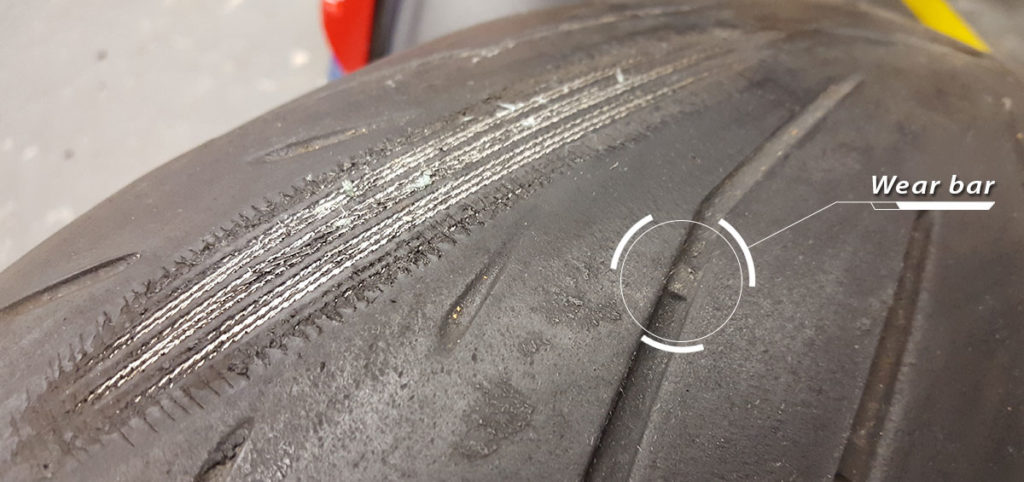
There is such a simple, elegant solution that we really wish Pirelli would employ it; put little wear dots down the center of the tire (the same thing used on slick race tires). When the dots wear away you’d be able to tell the tire is at the end of its service life and ready to be replaced.

CanyonChaser Approved!
It’s hard to find a bad motorcycle tire these days, which is why we’ve been so excited to see one rise to the top like the Angel GT. Like we mentioned earlier, this tire has been such a brilliant performer we’ve had a hard time wanting to run anything else. This is an excellent tire that does just about anything we could ever want; of course it would be nice if it lasted twice as long with the exact same level of grip, but even we realize that’s a bit unrealistic, at least for now.
In any case, the Pirelli Angel GT is CanyonChaser Approved. Give them a try; we’re confident you’ll like them. For more information visit the Angel GT webpage.
